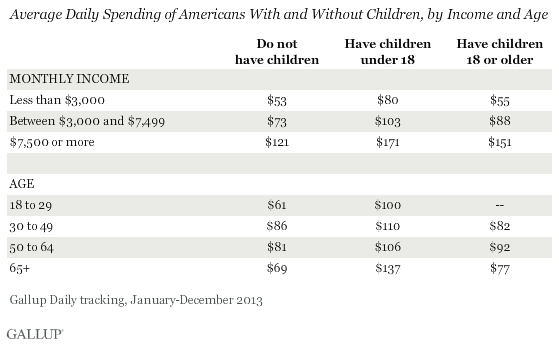WASHINGTON, D.C. -- Americans who have at least one child under the age of 18 report spending $29 more daily, on average, than those without younger children. Parents with younger children across all age and income groups report higher spending levels.

These results are based on 2013 Gallup Daily tracking, which asks Americans about the amount of money they spent on purchases "yesterday," excluding normal household bills and major purchases. Americans without children under 18 reported average daily spending of $79, while Americans with children reported a $108 daily average.
A multivariate analysis confirms that this difference in spending is significant when controlling for income, age, education, and marital status. That is, even among adults in the same income group, for example, there is an incremental bump in spending as a result of having children under 18. This could be the result of having more people in the house to provide basic necessities for, including food and clothing. In addition, there is a whole separate class of expenses that are common for parents, including children's extracurricular activities, books, toys, and games. Overall, the presence of children is clearly related to a higher outflow of money on a daily basis.
Americans' Daily Spending Declines Once All Their Children Turn 18
Once children move beyond the age of 18, their parents' spending appears to drop back down, approaching the levels found among those without children. This holds true across most income and age groups. In all demographic groups but one, spending is lowest among those without children, rises among those who have children under the age of 18, and then falls among those whose children are aged 18 or older.

Having More Children Under 18 Linked to Higher Daily Spending
The total number of children under the age of 18 also affects the amount Americans spend. Aside from those with no children younger than 18, parents with one child in this age category spend the least ($96 per day), while those with five or more spend the most on average ($145). Overall, there is a clear, upward trend: the more children under 18 there are in a household, the more money parents spend on a daily basis.

Bottom Line
Gallup research shows that marital status affects daily spending. These data show that having children younger than 18 has an effect on daily spending that goes above and beyond other demographic factors such as income, age, and marital status.
The drop in U.S. fertility rates in recent years, documented by the Centers for Disease Control and Prevention, therefore may have had a negative effect on consumer spending. The good news for the economy is that Gallup research also shows that there may be a pent-up fertility demand in the American population. If the fertility rate does increase in the years ahead, consumer spending may increase correspondingly.
Survey Methods
Results for this Gallup poll are based on telephone interviews conducted Jan. 2-Dec. 29, 2013, on the Gallup Daily tracking survey, with a random sample of 172,556 adults, aged 18 and older, living in all 50 U.S. states and the District of Columbia.
For results based on the total sample of national adults, the margin of sampling error is ±1 percentage point at the 95% confidence level.
For results based on the total sample of Americans with children under 18, the margin of sampling error is ±1 percentage point at the 95% confidence level.
Interviews are conducted with respondents on landline telephones and cellular phones, with interviews conducted in Spanish for respondents who are primarily Spanish-speaking. Each sample of national adults includes a minimum quota of 50% cellphone respondents and 50% landline respondents, with additional minimum quotas by time zone within region. Landline and cellular telephone numbers are selected using random-digit-dial methods. Landline respondents are chosen at random within each household on the basis of which member had the most recent birthday.
Samples are weighted to correct for unequal selection probability, nonresponse, and double coverage of landline and cell users in the two sampling frames. They are also weighted to match the national demographics of gender, age, race, Hispanic ethnicity, education, region, population density, and phone status (cellphone only/landline only/both, and cellphone mostly). Demographic weighting targets are based on the most recent Current Population Survey figures for the aged 18 and older U.S. population. Phone status targets are based on the most recent National Health Interview Survey. Population density targets are based on the most recent U.S. census. All reported margins of sampling error include the computed design effects for weighting.
In addition to sampling error, question wording and practical difficulties in conducting surveys can introduce error or bias into the findings of public opinion polls.
For more details on Gallup's polling methodology, visit www.gallup.com.
